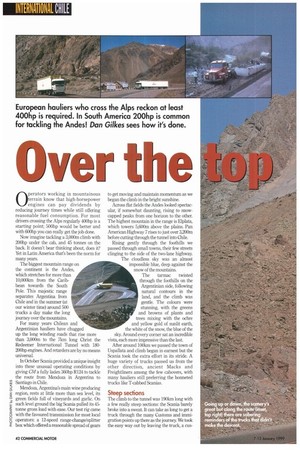lIver the
Page 44

Page 45

If you've noticed an error in this article please click here to report it so we can fix it.
0perators working in mountainous errain know that high-horsepower engines can pay dividends by reducing journey times while still offering reasonable fuel consumption. For most drivers crossing the Alps regularly 400hp is a starting point; 500hp would be better and with 600hp you can really get the job done.
Now imagine tackling a 3,000m climb with 200hp under the cab, and 45 tonnes on the back. It doesn't bear thinking about, does it? Yet in Latin America that's been the norm for many years.
The biggest mountain range on the continent is the Andes, which stretches for more than 10,000km from the Carib bean towards the South Pole. This majestic range separates Argentina in ill Chile and in the summer (at our winter time) around 500 trucks a day make the long journey over the mountains.
For many years Chilean and Argentinian hauliers have chugged up the long winding roads that rise more than 3,000m to the 7lon long Christ the Redeemer International Tunnel with 180200hp engines. And retarders are by no means universal.
In October Scania pructided a unique insight into these unusual operating conditions by giving CM a fully laden 360hp R124 to tackle the route from Mendoza in Argentina to Santiago in Chile.
Mendoza, Argentina's main wine producing region, rests at little more than sea level, its green fields full of vineyards and garlic. On such level ground the big Scania pulled its 45tonne gross load with ease. Our test rig came with the favoured transmission for most local operators: a 12-speed range-change/splitter box which offered a reasonable spread of gears
to get moving and maintain momentum as we began the climb in the bright sunshine.
Across flat fields the Andes looked spectacular, if somewhat daunting, rising to snowcapped peaks from one horizon to the other. The highest mountain in the range is Elplata, which towers 5,600m above the plains. Pan American Highway 7 rises to just over 3,200m before cutting through the tunnel into Chile.
Rising gently through the foothills we passed through small towns, their few streets clinging to the side of the two-lane highway.
The cloudless sky was an almost impossible blue, deep against the snow of the mountains.
The tarmac twisted through the foothills on the Argentinian side, following natural contours in the land, and the climb was gentle. The colours were stunning, with the greens and browns of plants and trees mixing with the ochre and yellow gold of sunlit earth, the white of the snow, the blue of the sky Around every corner sat an incredible vista, each more impressive than the last.
After around 100km we passed the town of Uspallata and climb began in earnest but the Scania took the extra effort in its stride. A huge variety of trucks passed us from the other direction, ancient Macks and Freightliners among the few cabovers, with many hauliers still preferring the bonneted trucks like T-cabbed Scanias.
Steep sections
The climb to the tunnel was 190km long with a few really steep sections: the Scania barely broke into a sweat. It can take as long to get a truck through the many Customs and immigration points up there as the journey. We took the easy way out by leaving the truck, a cus
tomer vehicle belonging to Mendoza haulier Expreso Felipe Andreu y Hijos, at the first Customs post, catching the bus and picking up another R124 at the other end of the tunnel.
Even so it took a few hours to clear Customs. Having left Mendoza at 08:00hrs we didn't get into Chile, after just 190km on the road, unti115:00hrs.
Hairpin bends
Coming up the mountain was easy; the Chilean descent was anything but. We were faced by Los Caracoles, a series of 39 tortuous hairpin bends descending into the growing gloom. The road drops 1,300m in just 16km of sinuous tarmac. The run down Carter Bar will never seem the same again.
Fortunately the Scania was equipped with an effective retarder which was a godsend on the tight bends and sudden drops. Long lines of ageing trucks, belching black smoke and moving at little more than a crawl up the road towards us, bore testimony to the rate of climb.
As the road levelled out, a roadside shrine covered in truck number plates came as a sobering reminder that some trucks have not been as lucky as us. We passed an ancient orange pre-1 Series Scania facing back up the hill with a dented side and lopsided front wheels. Further down the road its tanker tr-ailer lay on its back, the truck's fifth wheel still attached—it had been ripped clean off the tractor. Another 50 yards and we found a triaxle bogie, torn from the trailer during what must have been a nightmarish accident.
Two drivers were standing by the truck discussing the wreck. No one was injured so we carried on, but it was a timely reminder that a 45-tonne truck can soon get away from you on roads such as these.
We arrived at the Chilean foothills after a couple of hours driving, coming to the town of Los Andes by 1915hrs. We'd been on the road for 11 hours, and covered little more than 3(X)km—most of it up and downhill.
As the sun began is descent behind the mountains we had one last glimpse of a snowcapped peak before the Andes became little more than a brooding shadow in the gloom. Some drivers make that journey two or three times a week. It was a fascinating drive, but once was enough...
































































































